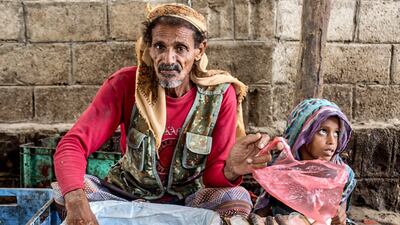As global attention on Yemen is focused on a fragile peace deal in Hodeidah reached in Sweden six months ago, nearly a quarter of a million civilians have become displaced since it was agreed, the Norwegian Refugee Council (NRC) said on Tuesday.
The internationally recognised government and Houthi rebels agreed upon a ceasefire deal for the Red Sea port city last December, which was seen as the first major diplomatic breakthrough in the conflict.
But the ceasefire was specific only to the port city as the war continues across the country.
“The Stockholm Agreement remains nothing but ink on paper if warring parties and their backers do not act now,” Mohamed Abdi, NRC’s Yemen country director said in a statement.
Displacement continues to persist with over 255,000 people forced to flee their homes, according to the International Organisation of Migration (IOM).
Hodeidah – home to the battleground port at the centre of the deal, vital as it provides the landing point for most of Yemen's food and aid deliveries – witnessed the largest number of people displaced in the past four years.
“Over 26,000 people were made homeless since the signing of the agreement,” NRC said in a statement.
In the first five months since the deal was signed, the average daily civilian casualty toll increased by a third across the country.
Hodeidah had the highest rate in the country which made up a quarter of nationwide civilian casualties, said NRC.
"Over 1,750 civilian casualties were reported across Yemen, including over 500 fatalities," the organisation said.
“More than three times the number of civilians were killed or injured by small arms fire in the five months after the ceasefire than the same period preceding it,” NRC said.
In total, the ongoing conflict has led to the displacement of more than 3.6 million people, according to IOM.
“Yemen’s best chance of stopping hunger and ending the 4-year conflict risks fizzling into another failed peace attempt, despite the recent troop withdrawals from Hodeidah ports,” said Mr Abdi.
The development comes as an aide to UN Secretary General Antonio Guterres held “productive” discussions with Yemen’s President Abdrabu Mansur Hadi on Monday evening.
"The meeting was good and productive," a Yemeni official told The National.
The UN undersecretary general for political affairs, Rosemary DiCarlo, met with officials from the Yemeni government to defuse a row about Martin Griffiths, UN’s envoy to Yemen, whom they accuse of siding with Houthi rebels.
Mr Hadi said in a letter addressed to the UN chief that he “can no longer accept these offenses” by the envoy.
The government’s dispute with Mr Griffiths is over the rebel handover of Hodeidah’s ports to coastguards that the government says is in fact rebel fighters in different uniforms.
The meeting follows the resignation of Yemen's Foreign Minister, Khalid Al Yamani, his office told The National.
The resignation must be accepted by Mr Hadi to officially confirm his departure, which is yet to be done.
Reasons behind Mr Al Yamani’s resignation remain uncertain, but alleged reports say that differences emerged within the government over the withdrawal of troops from Hodeidah.


